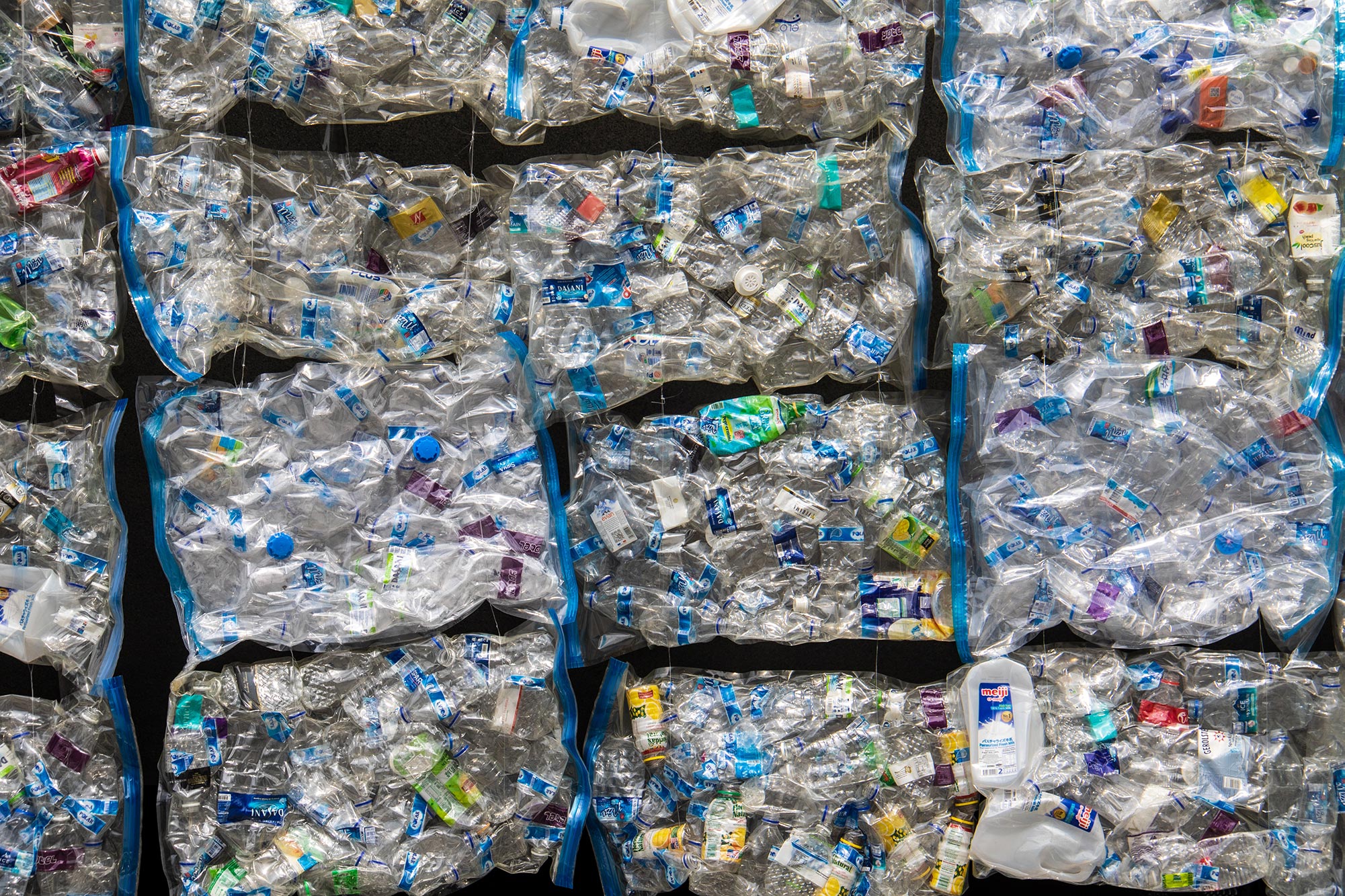
Can plastics recycling be profitable?

Plastics recycling in industrial areas
plastics, plastics recycling, circular economy, resource wisdom, business cooperation, port, waste, value chain, piloting, reuse
It has become apparent that more plastics need to be recycled. The purpose of this concept is to launch plastic recycling activities in industrial areas and to create cooperation between companies to achieve climate goals. An experiment was carried out to illustrate the functionality of recycling, to obtain information about the volumes of plastics and to collect feedback from companies in Vuosaari Harbour.
- 6443 kg/year: the theoretical amount of plastic waste generated in Vuosaari Harbour.
- 80% of the collected plastics could be reused instead of being used to produce energy according to the pilot project.
- Emissions: carbon dioxide emissions are significantly lower in recycling-oriented solutions than in the current solution in which plastic waste is mainly burnt.
This solution is suitable for
- cities that want to encourage companies to do their bit for climate change;
- companies that want to start recycling their waste or improve their existing procedures;
- companies that are looking for new business opportunities in the recycling sector.
BASIC FACTS
- Location: Vuosaari Harbour, Helsinki
- Life cycle: active phase.
- Organisers: Satu Pasanen/VTT Technical Research Centre of Finland, Juha Hakala/VTT Technical Research Centre of Finland, Saara Pellikka/City of Helsinki.
- Time span: 3 months – 1 year.
- A ‘plastic pilot’, a joint experiment to collect plastic waste from companies, was carried out during the concept development phase. Packaging plastics and plastics from logistics operations were collected from companies in Vuosaari Harbour. The pilot project was carried out in cooperation with the City of Helsinki and the Port of Helsinki between 16 November and 31 December 2020.
- The recycling solutions were compared to the current ones from the perspective of the economy and carbon emissions.
- The concept encourages the reuse of plastics.
The first plastic recycling concept in Vuosaari Harbour
National and international targets, such as the plastics roadmap for Finland and the EU plastics strategy, accelerate the recycling of plastics. The concept was inspired by the enthusiasm of companies in Vuosaari Harbour for recycling – it started at the grassroots level. The purpose of the concept is primarily to start collecting plastics in the industrial area and, secondarily, to promote cooperation between competing companies to achieve the climate goals.
During the conceptualisation phase, a pilot project was carried out in collaboration with public-sector operators, companies and a research institute. Practical experiments such as this produce scientifically valid and pragmatic data, encourage companies to try new work methods and increase dialogue between cities and businesses.
Piloting provides facts for conceptualisation
A ‘plastic pilot’, a joint experiment to collect plastic waste from companies, was carried out during the concept development phase. Packaging plastics and plastics from logistics operations were collected from companies in Vuosaari Harbour. The pilot project was carried out in cooperation with the City of Helsinki and the Port of Helsinki between 16 November and 31 December 2020. Seven logistics companies took part. Plastic material was collected in a waste compactor equipped with a smart scale, which was on loan from Europress Group Oy for the duration of the test.
A total of 812 kg of various types of plastics was collected, mainly polyethylene (LDPE) and polypropylene (PP), which were taken to be reused. The plastic materials were sufficiently clean for the purposes of the collection experiment. Participants filled in a questionnaire afterwards that collected feedback and user experiences for concept development. Most participants found it easy to take part in the plastic pilot and joint collection efforts. Companies thought that collaboration was viable, especially with regard to waste management and other environmental services.
Comparative information with economic and environmental perspectives
The economic perspective was illustrated and assessed in the context of Vuosaari Harbour’s location and the pilot carried out there. Different solutions were created for this industrial area in terms of waste management and recycling, and in addition to the current situation, two alternative solutions are presented, A and B. In the current situation (REF), plastic waste is not recycled but is sent to be burnt at a waste-to-energy facility. Solution A does not involve sorting at the place of origin but all plastic waste is put together and taken to a recycling company. In solution B, plastic waste is sorted at the place of origin, i.e. only LDPE and PP plastic waste is collected.
The results show that the current situation (REF) is the cheapest if only 6.5 tonnes of plastic waste is generated per year, but this option becomes the most expensive as the amount of waste increases. Solutions A and B, which encourage people to recycle, are more economical when the volume is 1.5–2 times higher. Carbon emissions in solutions A and B are significantly lower than in the reference situation. An increase in the amount of plastic waste in solutions A and B generates lower level of emissions than the reference situation.
Putting the concept into practice
The concept is based on solution B, in which the LDPE and PP waste collected from the companies in the port is sent to mechanical recycling. There is also already an industrial recycling solution. As it develops, the concept aims to apply solution A, in which a wider variety of plastic waste can be collected and sent either to be reused as recycled material or as material for the petrochemical industry. Introducing solution A will require cooperation with a suitable recycling or sorting company located near the industrial area. In both solutions, the flow of plastic waste from nearby areas is added to the flow from the port as this increases the impact on the local area. The concept is based on the idea that plastic waste generated in the area is returned there in products used in the area (e.g. packaging films or bags) or is used in products such as fuels used by machines in the area.
All respondents said that a joint collection of plastics should remain a permanent part of the port’s operations. The joint collection model is easy to adopt and scale to suit different types of industrial areas. Expanded to cover the whole country, this type of activity in industrial areas would have the potential for substantial emissions reductions.

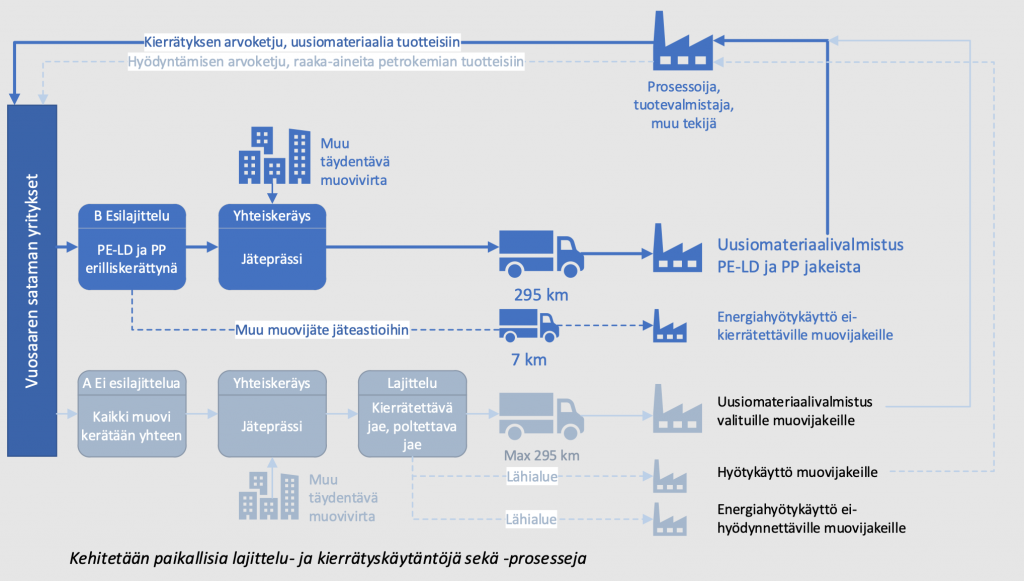
TAKE-HOME MESSAGES
- Companies are enthusiastic about plastic recycling and they want their operations to be more sustainable.
- Piloting provides scientifically valid, practical information on the amount of waste generated in an area and companies’ recycling-related requirements and practices.
- Competing companies can collaborate and gain environmental and economic benefits.
- Cities will be able to persuade companies to adapt the climate goals by launching new pilot projects that focus on emissions reductions and resource wisdom and that benefit companies in the short or long term.
“As the global use of plastics increases, we need recycling to curb this trend. Solutions are created at the local, national and international level. Recycling captures plastic waste for reuse or recovery and offers environmental and economic benefits to businesses.”
– Satu Pasanen, Research Scientist, Circular Economy Developer, VTT Technical Research Centre of Finland
Download
Links

How can climate action be measured in industrial areas?

Measuring carbon neutrality and resource wisdom
emission-free construction site, monitoring system, Technical Research Centre of Finland (VTT), life cycle assessment, measurement, emission calculation, resource wisdom, climate change mitigation
In order to effectively monitor the carbon neutrality and resource wisdom measures of industrial areas, emission calculations and monitoring tools must be continuously developed and applied. Emission reductions achieved in industrial areas are significant in view of the climate targets of their adjacent cities as the targets cannot be met without a contribution from businesses.
• Two construction sites: low-emission construction machinery were piloted in Espoo and Helsinki.
• Cooperation: the development of a monitoring system for construction site emissions started as a collaboration between the Technical Research Centre of Finland and the contracting entities of cities that are signatories to the sustainable procurement Green Deal agreement for emission-free construction sites.
• Plastic: the impact of plastic recycling on greenhouse gas emissions from waste treatment was assessed in a trial carried out in the Vuosaari Harbour area.
This solution is right for you if
- you are looking for general information on measurement and calculation methods related to carbon neutrality and resource wisdom targets for industrial areas and construction sites.
BASIC FACTS
- Location: emission-free construction site pilot in Espoo and Helsinki, Vuosaari Harbour, Blue Industry Park in Turku, energy efficiency project in Vantaa
- Implemented by: participants in the HNRY project (Carbon-neutral and resource-wise industrial areas project)
Emission reductions in industrial areas are important for the climate targets of the participating cities
The cities have set ambitious climate targets, and they aim to achieve carbon neutrality by 2035. When a city aims for carbon neutrality, it means that emissions produced within that area are reduced to a set level (e.g. 80% of the level of 1990) and the remaining emissions are compensated.
With regard to resource wisdom, cities aim for long-term targets that are based on EU targets (by 2040). Becoming resource-wise requires close interaction and development work, including in the management of materials and logistics, between the different project participants. For example, possibilities for resource-wise and energy-efficient use of construction machinery were reviewed at Vuosaari Harbour. There is also massive potential in materials recovery and intensifying circular economy as the plastic pilot project showed.
Basis and scope of emission calculations
The state and municipalities base their emission calculations on production or area. They include all greenhouse gas emissions produced within the set area (Scope 1) and emissions from the production of energy purchased from an outside source (Scope 2). When measuring the carbon neutrality of an individual business, the calculation can focus on direct GHG emissions (Scope 1), such as the use of fuels in energy production and in vehicles, and on indirect GHG emissions (Scope 2), such as emissions from the production of purchased electricity and district heating. The rest of the emissions are compensated (Scope 4).
For industrial areas, it is best to base the calculation on consumption so that emissions from the production, transport and disposal of products and services produced and consumed within the industrial area during a set period of time (Scope 3) are taken into consideration. An example of a consumption-based calculation can be found in the concept of emission-free construction sites for the Lukutori construction site.
Emission-free construction site – calculation scope and tools
Constructions sites usually have clear boundaries within which direct emissions are produced. Maintenance sites are not as clearly defined. Materials, fuels and purchased electricity mainly come from outside these boundaries. The scope of the emission calculation for a construction site depends on which processes are identified as most significant in terms of emissions.
In the Lukutori pilot project in Espoo, the majority of emissions were identified as being indirect emissions. The consumption-based calculation used also factored in emissions from the use and production of the fuel in the machinery, the production of batteries and electricity used for electricity-powered machinery, the production of electricity used for on-site power generation and the production and transport of materials used on site.
The emission calculation for the Kulosaari pilot construction site in Helsinki included emissions from the production of fuels (including biofuel) used in construction machinery as well as emissions from the production of electricity used by machinery and the construction site.
The lack of an established monitoring system has made it difficult to monitor the data needed for emission calculations. The parties to the Green Deal agreement for emission-free construction sites are in the process of developing a monitoring tool to be introduced by the end of 2022. The introduction of the monitoring tool and new practices will require contractors and machinery operators to be trained in order to ensure the quality of the data collected.
Data and tools for measuring and monitoring the climate action of industrial areas
An extensive overview on the factors affecting the resource wisdom and carbon neutrality of an industrial area has been drawn up and included in the Turku Blue Industry Park Guide. The scale does matter as energy-efficiency investments and the energy production of an entire industrial area or a cluster of businesses can bring significant emission reductions. An area can even become climate positive.
A pilot project that trained individual companies using company-specific customised content also produced training material for public use. Company training can be used to raise awareness of emission sources, assist with calculations and the implementation of climate measures.
In Espoo and Helsinki, the emissions of an emission-free construction site were compared to those from an “ordinary” construction site. The sustainable procurement Green Deal agreement for emission-free construction sites will help to harmonise practises and introduce monitoring tools for contracting entities.
Municipalities’ emission calculations tend to follow common guidelines but individual organisations and companies can apply such varying scopes and methods for calculating indirect emissions that it compromises the comparability of the results. There is a need for harmonisation, and this is why the experience gained during projects should be put into practice more widely.
TAKE-HOME MESSAGES
- The most sensible emission calculation method for an industrial area is consumption-based calculation.
- It is important to maintain the transparency of the calculation method and the reasons for the set scope.
- There is a need for methods to be harmonised, and therefore the experience in calculation methods and tools gained during projects should be actively put into practice more widely.
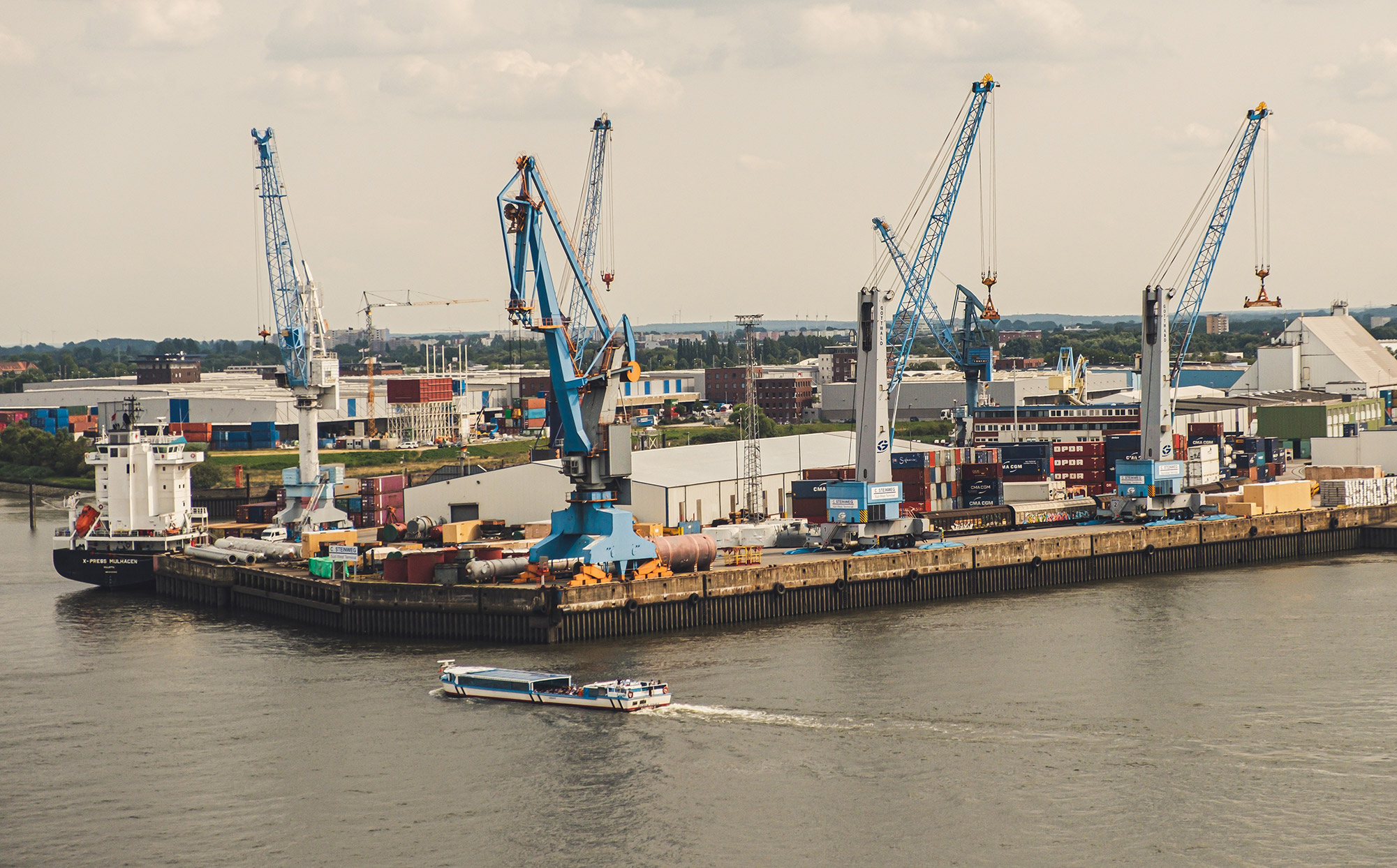
Is carbon neutrality and resource wisdom in a gated industrial area too narrow a perspective?
A resource-wise and carbon-neutral maritime industry network
reduce, reuse, recycle
The project developed an optimal operating model for flows of materials, resources and information in the Blue Industry Park and Turku Shipyard. The model can be used to achieve resource wisdom and carbon neutrality throughout the supply chain.
- 20–30% increase in value-adding operations.
- 3–7% reduction in material loss.
- 20% better production turnaround time through supply chain transparency and management.
- 5% lower material costs through centralised procurement.
This solution is right for you if
- you operate in the supply chain of Turku Shipyard;
- you operate in a manufacturing industry supply chain;
- you want to streamline your supply chain operations.
BASIC FACTS
- Location: Perno district, Turku. Next to Turku Shipyard.
- Industrial area life cycle: planning phase
- Organiser: Blue Industry Park Oy.
- Time span: 5–10 years from 2021 onwards.
- 600 companies in the supplier network.
- The maritime industry network in southwestern Finland employs 11,000 people.
- The turnover of the maritime industry network was EUR 3.3 billion in 2019.
The aim is to increase the efficiency of the maritime industry network
The concept identified how the operations of the maritime industry network could be streamlined, and an operating model was created for the planning and implementation of these improvements. The aim was to optimise the material, resource and information flows between the Blue Industry Park (BIP) and Turku Shipyard. The project assessed what kind of operating methods the companies in the maritime industry network should use in order to make the network’s operations as resource-wise and carbon-neutral as possible. Finally, it was determined what kind of control system would support resource-wise and carbon-neutral operations.
The logistics centre offers the best support to resource-wise and carbon-neutral operations
The concept determined which activities should be located in the BIP area in order to make the maritime industry network as efficient as possible and to support resource-wise activities. The key functionalities were production facilities and the logistics centre.
The need for production facilities varies: some operators require a small workshop while others need a larger production facility. The premises to be built must also be adaptable so that they can meet the changing demand. Pre-assembly and modularisation would also reduce the logistical burden in terms of traffic volumes and packaging materials. Traffic volumes are reduced when larger entities are transported and there are fewer deliveries of parts and components in the area.
Recycling reduces material waste
Recycling packaging waste and standardising transport packaging in the area would be very beneficial. If standardised methods were used for recyclable packaging materials, logistics operations would be clearer and the volume of packaging materials in the area would be reduced.
Building a centralised recycling centre in the BIP would serve companies in the area and help ensure that waste materials are recycled. The recycling centre would operate in the area between the BIP and the shipyard, which would be ideal for all parties.
With regard to the location of functionalities, traffic going into the shipyard must also be considered. The logistics centre should be located either beside or in the immediate vicinity of the production facilities in order to avoid any unnecessary traffic.
Information creates trust
Yhteistoiminnan ja resurssiviisauden edistämiseksi tarvitaan mitattua tietoa. Konseptiin liittyen määriteltiin viisi tärkeitä mittaria:
Measured data is required to promote collaboration and resource wisdom. Five important indicators were identified in relation to the concept:
- Security of supply of incoming materials
- DIFOT (Delivered In Full and On Time)
- Security of supply of site-specific material packages
- DIFOT (Delivered In Full and On Time)
- Progress of the site-specific plan
- Timing and accuracy of master production scheduling
- Timing and accuracy of detailed planning
- Implementation of the plan content
- Monitoring deviations
- Work package-specific monitoring
- Delivery line-specific monitoring
- Monitoring of transport volumes
- Monitoring of inbound logistics
- Monitoring of reverse logistics and material loss, surplus/waste
- 3R strategy (Reduce, Reuse, Recycle)
TAKE-HOME MESSAGES
- Material wisdom: centralised materials management can reduce material waste.
- Resource wisdom: minimising the amount of surplus material with more careful planning.
- Information wisdom: the information flow generated by the digital platform enables supply chain management and development.
“Stopping structural waste is the only way to save the planet.”
–Ari Viitanen, HPJ CarinaFour
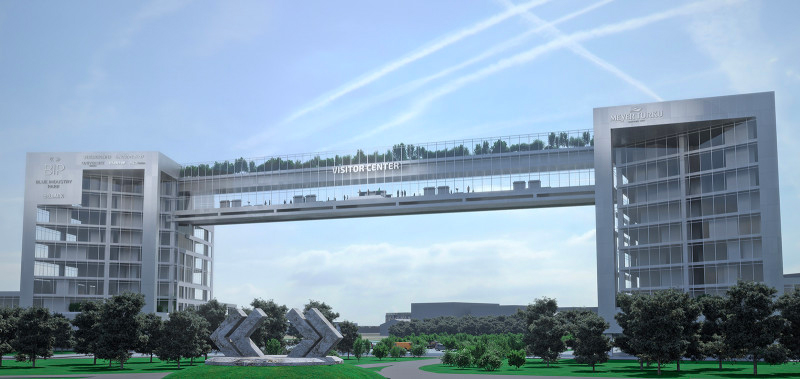
How to create a new resource-wise and carbon-neutral industrial area?

Blue Industry Park: the new resource-wise and carbon-neutral industrial area
hiilineutraali teollisuusalue
When building a carbon-neutral and resource-wise industrial area, it is necessary to take into account not only the planning but also the construction of the area and its day-to-day operations. The Blue Industry Park is an area that is gradually being built beside the Turku Shipyard, and it will be a functioning ecosystem of manufacturing industries and service operators. It takes the expertise and willing of all companies to achieve resource wisdom and carbon neutrality in the area.
- Blue Industry Park Oy. Established during the project to lead the construction of the area.
- Great transport links. Deep-water channel, E18, railway and distance to the airport 10 km.
- 55 hectares. Total area
This solution is right for you if
- you operate in the supply chain of Turku Shipyard;
- you operate in a manufacturing industry supply chain;
- you want to streamline your supply chain operations;
- you are planning a carbon-neutral and resource-wise industrial area;
- you are a contractor or developer in a carbon-neutral and resource-wise industrial area;
- you are a public operator, such as a planning officer, and you want to know how carbon neutrality and resource wisdom are implemented.
BASIC FACTS
- Location: Perno district, Turku. Next to Turku Shipyard.
- Industrial area life cycle: planning phase
- Organiser: Blue Industry Park Oy.
- Time span: 5–10 years from 2021 onwards.
- The maritime industry network in southwestern Finland employs 11,000 people.
- The value of Turku Shipyard’s order book in Q1/2021 is EUR 6.5 billion, cruise ship deliveries until 2026.
Towards a sustainable future
Blue Industry Park is a close-knit and diverse community of companies and research institutes, which are leading the change. There are no limits to its growth opportunities. The scalable spaces and shared resources provided in the area reduce the need for non-essential investments and enable business development in a sustainable and commercially viable manner. The community is responding to megatrends of production modularity and circular economy on a scope never seen before.
New technologies and cooperation are prerequisites for success
The concept guidelines do not provide ready-made solutions for the future, but they encourage all parties to share their expertise to achieve the shared goal. For the area to be successful, the best and most sustainable technologies and operating models available must be applied in every phase and solution.
The guidelines cover solutions for design and civil engineering, buildings and operations as well as transport.
Blue Industry Park’s ecosystem also includes service companies such as occupational health care, lunch restaurants and a visitor centre. Renewable energy sources are preferred, of course, and carbon neutrality is achieved by combining several solutions.
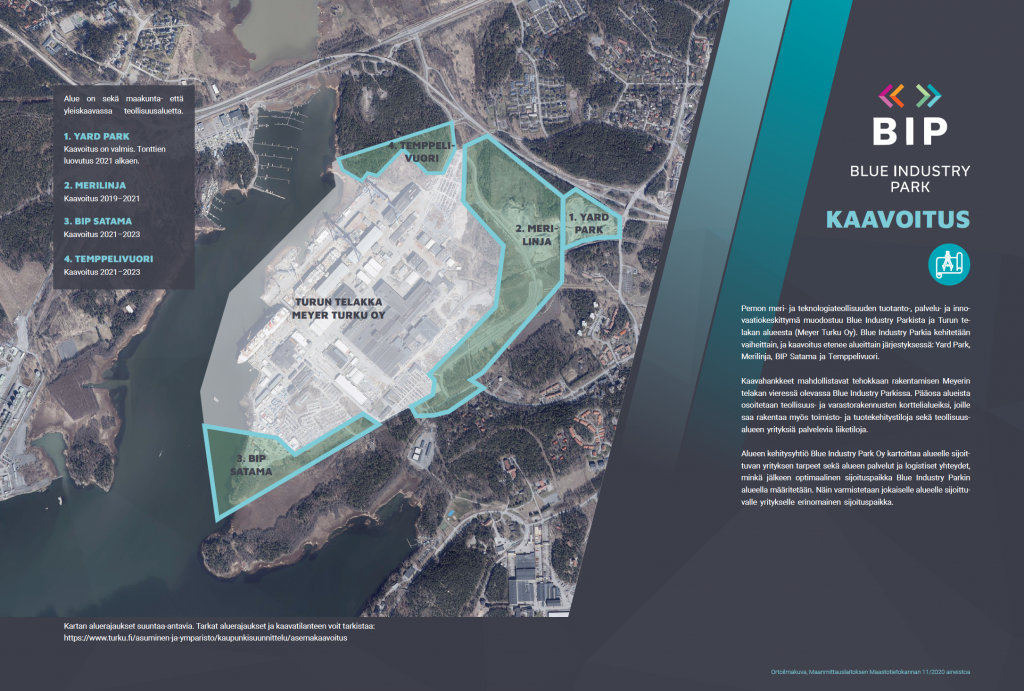
Research collaboration with universities
It is valuable for companies operating in the area that there are four institutes of higher education in Turku with research related to the maritime industry and maritime logistics. Blue Industry Park is a platform for productive cooperation in research projects and the supply of skilled labour both now and in the future.
The universities in Turku cover disciplines that are relevant to planning and building the area, such as energy technology, structural engineering, circular economy, economics and industrial management engineering.
TAKE-HOME MESSAGES
- The area’s location in relation to existing transport links and major customers is essential to minimise emissions from transport.
- When building the area, the use of land masses in the region and the area under construction must be optimised so that unnecessary transportation and costs can be avoided.
- Renewable energy production, transmission and storage solutions need to be considered at the planning phase.
- The flexibility and modularity of the facilities improve their occupancy rate and cost efficiency.
- Sharing machinery and equipment makes it easier to adopt new eco-friendly technologies and reduces the number of equipment needed in the area.
- There must be a leader with a clear role to create an area that runs on synergy and cooperation.
”Companies must assess and develop their practices: new ideas only come from doing things differently. We know that those who can realise their full growth potential, find the right partners and work in a carbon-neutral and resource-wise manner will be successful.”
– Tero Lahti, CEO, Blue Industry Park Oy.
Download
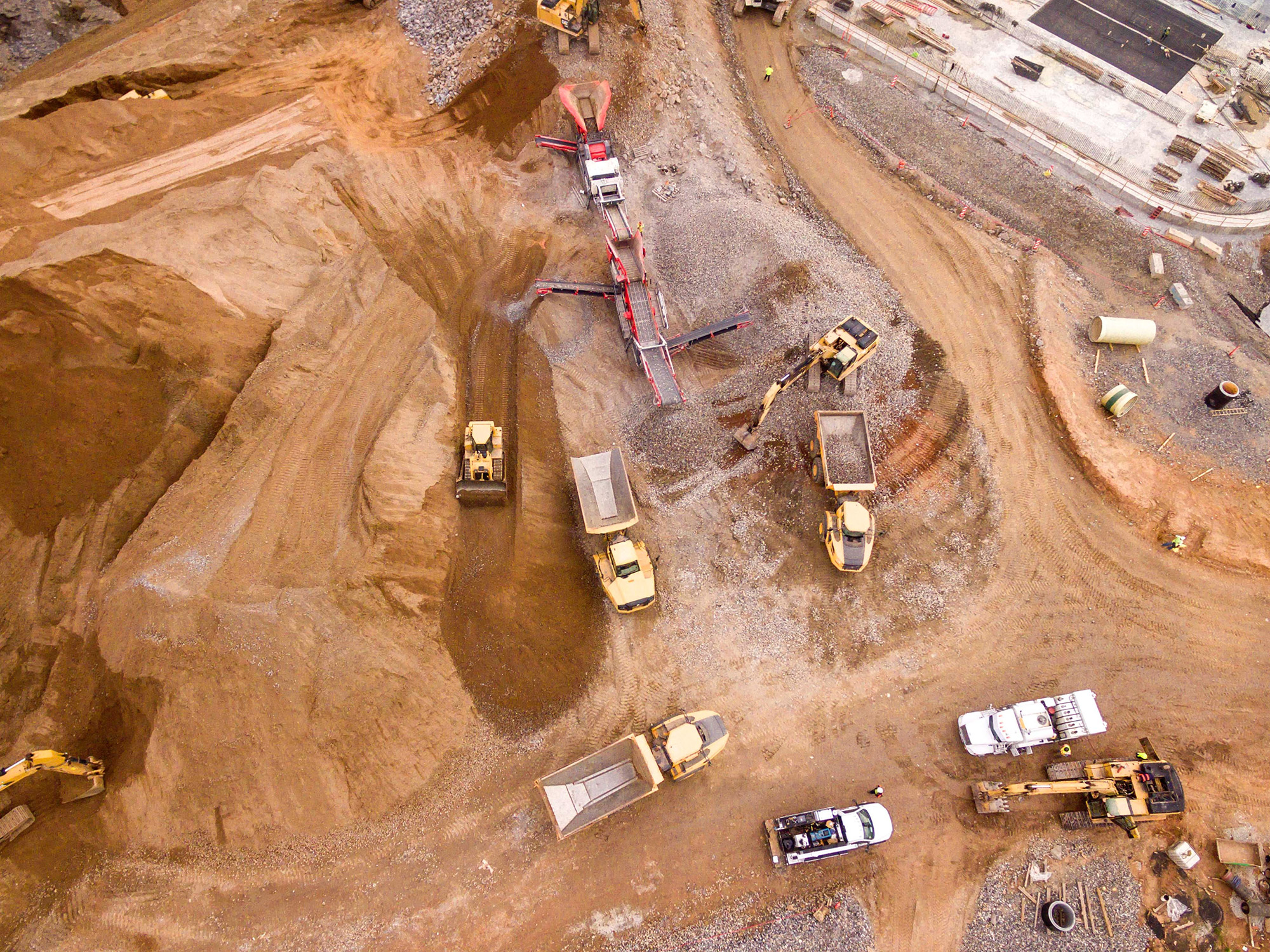
Is there any use for surplus clay from construction sites as landfills fill up?

Utilising surplus clay from construction sites
clay, infrastructure, mass economy, construction sites, aggregate, thermal treatment, recycled lightweight expanded clay aggregate, aggregate products, waste heat, production side streams
We studied the use of clay as a component in an aggregate product that could be used in land development while reducing the climate impact of construction. The use of clay as a production material could potentially reduce emissions and costs caused by the transportation of clay and production of virgin materials for construction.
- Supply and demand
The profitability of using clay as a raw material is primarily determined by the market potential of the product or products and the cost structure of the production plant. Surplus clay as a raw material is practically free, and directing the currently levied landfill gate fees differently could serve as an incentive for using clay as a raw material in production.
- Environmental permits
The surplus clay from construction sites is classified as waste if it is not assigned to be used for something else. This classification of clay as waste can be prevented by conducting relevant research and planning in advance, but soil could be used much more efficiently if clay that has already been dug up could also be reclassified.
- Cooperation
The key to the successful use of clay is to rethink established practices in “ecosystems” where operators in different sectors can collaborate to develop opportunities for business around circular economy.
This solution is right for you if
- you work with geotechnics or mass coordination;
- you are a developer in an area with a large number of clay pits (capital and coastal regions) and a fast growing city with many construction projects; or
- you plan business operations that use industrial side streams and waste heat.
BASIC FACTS
- The location of the industrial area. Construction site, landfill. Concept implemented by the city of Espoo and its Public Works Department and Environment Centre. Ramboll acts as consultant.
- Duration: from October 2020 onwards. The study on clay is ongoing as a collaborative development effort coordinated by the Espoo Public Works Department.
- The city of Espoo provides the framework for the new circular economy-based business and brings together expertise, market knowledge and different interest groups.
The majority of the soil brought to the Kulmakorpi landfill is clay
Transferring surplus clay from construction sites to landfills creates both costs and emissions. Within our project, Espoo has tried to find a solution to the problem by looking into ways to process surplus clay produced across the capital region into a lightweight expanded clay aggregate. One of the central themes of circular economy is resource efficiency, which means the most efficient possible use and reuse of exiting materials. By using surplus clay, we can prevent the acquisition of virgin materials and the resulting climate and environmental impacts.
Our study on clay included basic research, test-baking clay from Espoo, a workshop and final report
In the study, the potential of clay as a raw material was examined while taking into account both production factors and market potential. The study examined, for example, the characteristics of clay with regard to thermal processing, potential forms of production and energy sources, applications for use and market potential.
Preliminary research consisted of expert interviews and discussions. The actual study included the examination of data and a workshop. During the workshop, the results from the preliminary research were further discussed, the Åbo Akademi University presented the results and conclusions of their thermal treatment testing, interest in the topic among operators in the industry was reviewed and knowledge and experience in the use of surplus clay was gathered from interest groups.
The thermal processing methods of clay are based on drying and burning. The treatment temperature and the physical and chemical properties of clay determine the properties of the final product. The expansion of clay is essential in the production of products such as lightweight expanded clay aggregate. The properties indicating expansion potential were found to include clay content, water content, dry unit weight and the quantity of organic material. Preliminary research on clay plays an important role in identifying the clay types suitable for production and ensuring smooth further processing. Preliminary research should be included in construction planning as early in the process as possible.
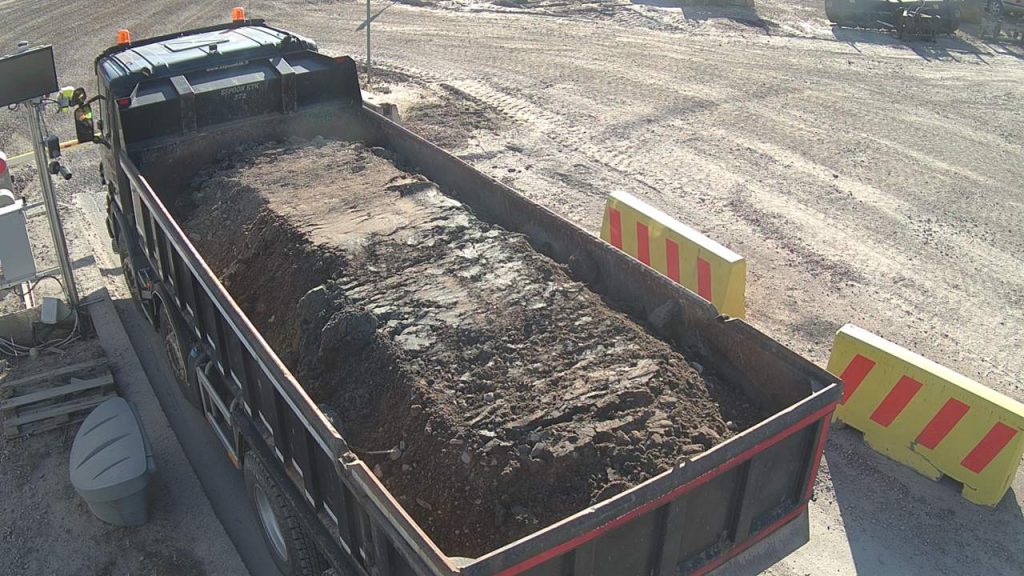
The market potential of a product is based on demand, i.e. the application potential and price in relation to similar products
Recycled lightweight expanded clay aggregate production can be divided into three “production lines”: 1) recycled lightweight expanded clay aggregate which does not meet the requirements of traditional lightweight expanded clay aggregates; 2) clay aggregate from crushed “burnt” clay; and 3) embankment clay, which is dried clay. Clay aggregate and embankment clay are terms used for the purpose of the study and they do not correspond with any official classification or existing products. This type of product would be used like stone aggregate and is in competition with virgin stone aggregate and some recycled materials that are typically low-cost materials. This means that any new product must either have properties that the competing materials do not have or must be cheaper.
The use of surplus clay, or any other recycled materials, requires communication across different sectors and extensive prior research
Our study on clay provides a preliminary overview of the potential of surplus clay as a raw material across the capital region. Research on the suitability of local clay types for thermal treatment provides basic information on the properties of these clays but a more detailed analysis of production or production potential requires further examination and studies. The use of clay in several different production lines or transportation of suitable clay raw material to an aggregate plant require further investigation. The discussions sparked by our study are the primary medium for exploring alternatives, altering practices identified as preventing the use of surplus clay and integrating resource sustainability as part of the construction industry.
With the current cost structure, producing recycled lightweight expanded clay aggregate or a similar product is more expensive than acquiring virgin stone aggregate. The cost structure of an aggregate product depends on how the costs of other uses of surplus clay are taken into account and how much saving natural materials and recycling are valued. Carbon dioxide emissions from materials may become a significant factor in procurement alongside cost and technical suitability. However, before the current conditions change, public operators play a key role in enabling the use of clay and providing potential sites for applications.

TAKE-HOME MESSAGES
- In order to launch the production of clay aggregate, we need a collaborative ecosystem in which operators in different sectors develop business opportunities around circular economy together.
- The profitability of using clay as a raw material in production is primarily determined by the market potential of the product or products and the cost structure of the production plant.
- In future procurements, the carbon footprint of products may become the decisive factor alongside cost.
- In addition to permits, such as environmental permits, the classification of clay as waste is a significant factor affecting the planning of production.
“When procurement decisions are based on CO2 emissions, the production of recycled aggregates can become profitable. For as long as money is the priority, public operators have a key role in enabling the use of clay.”
— Workshop participant
Download
Links

How can tenders promote emission reductions and resource wisdom?

Utilising surplus clay from construction sites
clay, infrastructure, mass economy, construction sites, aggregate, thermal treatment, recycled lightweight expanded clay aggregate, aggregate products, waste heat, production side streams
The invitation to tender for the pilot construction site of Lukutori Square in Espoo included new and updated environmental criteria with the goal to reduce emissions from the construction site and transport. At the same time, the project team also piloted green procurement strategies by developing zero-emission practices used on the site and promoting resource wisdom through actions such as using Finnish paving stones.
- Successful dialogue with the market. The procurement tender criteria we used were realistic for the contractors and compliant with the Act on Public Procurement and Concession Contracts (Laki julkisista hankinnoista ja käyttöoikeussopimuksista, 1397/2016). We received a total of four offers that met the criteria. New and updated environmental criteria are being introduced to contracting tenders on all construction sites of the City of Espoo.
- The Green Deal. During the course of the pilot project, the Green Deal agreement for sustainable procurement and zero-emission construction sites in public procurement was prepared together with the Ministry of the Environment. The criteria for heavy machinery and equipment laid down in the Agreement were also piloted on the Lukutori site, which provided support and information needed to update the procurement process.
- Material production and transport are the key to the most substantial emission reductions. Lukutori Square was built using Finnish paving stones instead of stones imported from China, where the stones are usually sourced from. If stones from China had been used in the pilot project, its total emissions would have been over three times higher. This requires more resources for planning and contracting tenders, but in the long run, carbon-neutral and sustainable construction is not more expensive; on the contrary, it helps save money.
This solution is right for you if
- you are a public procurement expert;
- you are a contractor planning to purchase new machinery or equipment or to retrofit/convert your existing equipment to reduce emissions; or
- you work in urban planning and your goal is to achieve a carbon-neutral city.
Perustietoja
- Location of the industrial area: Lukutori Square, Suurpelto/Henttaa, Espoo
- Concept executed by: City of Espoo: Public Works Department and Environment Department.
- Time frame: 6/2020–12/2020.
- Project partners: VRJ Etelä-Suomi, Ramboll Finland, the Association of Finnish Technical Traders, Ramirent Finland, Loimaan Kivi, Kekkilä, Residents’ association of Suurpelto.
- The Lukutori project team also piloted the principles of the Green Deal Agreement for Sustainable Procurement and Zero-emission Construction Sites, which was made between the Ministry of the Environment, the cities of Helsinki, Vantaa and Turku and Senate Properties in the autumn of 2020.
- In public procurement, invitations to tender may not list ‘Made in Finland’ as a selection criterion, but environmental declarations, such as EPD, are allowed. Based on life cycle analysis, Environmental Product Declaration, or EPD, is a voluntary and standardised declaration that reliably presents the essential and verified information about the environmental impact of a manufactured product or product range in a comparable manner.
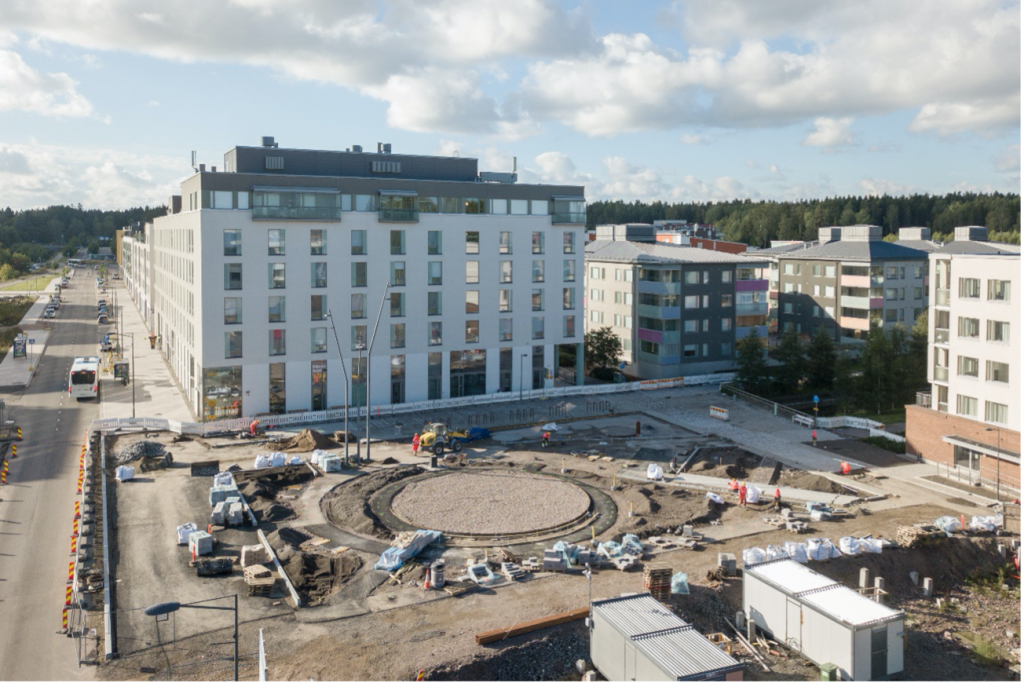
Procurement criteria promoting carbon neutrality and compliant with the Finnish procurement act were used in the pilot project on the emission-free Lukutori Square construction site
The site selected for the pilot project was the new central square and its adjacent streets in the district of Suurpelto in Espoo, as the scope of the contract was ideal for piloting new environmentally sound and sustainable procurement criteria. Stakeholders were invited to a market dialogue event where speakers talked about topics such as the construction industry’s climate targets and the availability of low-emission heavy machinery and equipment. After the event, contractors had the chance to participate in one-to-one discussions with the city. The purpose of the discussions was to analyse the contractors’ equipment fleet and their ability to make an offer based on the planned minimum criteria.
The invitation to tender was adjusted to include the minimum requirements for heavy machinery and heavy goods vehicles deemed realistic by the contractors and representatives of the heavy machinery industry, as well as emission-reducing construction site practices and the implementation of resource-wise strategies. The Lukutori Square pilot project challenged customers, contractors and other stakeholders to adopt new practices and strategies to build a better, carbon-neutral future. Successful criteria for contracting and equipment procurement and other emission-reducing principles and practices will be gradually introduced to all of Espoo’s construction sites, including building, infrastructure, renovation and demolition sites.

Adding new environmental minimum requirements to contracting tenders
The sustainable procurement process was adjusted by adding the requirement for using fossil-free biofuels, biogas or (green) electricity in the contractors’ heavy machinery and equipment. To help the contractor of the Lukutori site achieve the emission reduction target faster, the City of Espoo leased out a 4.2-tonne electric loader to be used on the site and granted the contractor a total maximum bonus of EUR 30,000.00 for using machinery and equipment powered by fossil-free fuels.
In the building contract programme of the pilot site, the contractor agreed to attend training on zero-emission construction sites to increase its understanding of how impactful and necessary the new operations and practices on the site can be. With more know-how, this also gives the contractor a competitive edge in future tenders.
The transport of paving materials was also taken into account in the minimum criteria for the procurement. The project team also piloted a real-time and site-specific solution supplied by Vediafi Oy that tracks and reports on emissions from transport. The pilot project’s costs do not increase when the procurement is evaluated over a longer period of time. More resources must be allocated to the planning and contracting tender stages of a construction project to ensure climate-positive results and quality requirements are achieved. The utilisation of digital solutions will need further research in future projects, as tracking the equipment and deliveries to and from the site requires more work and collecting information manually is practically impossible.

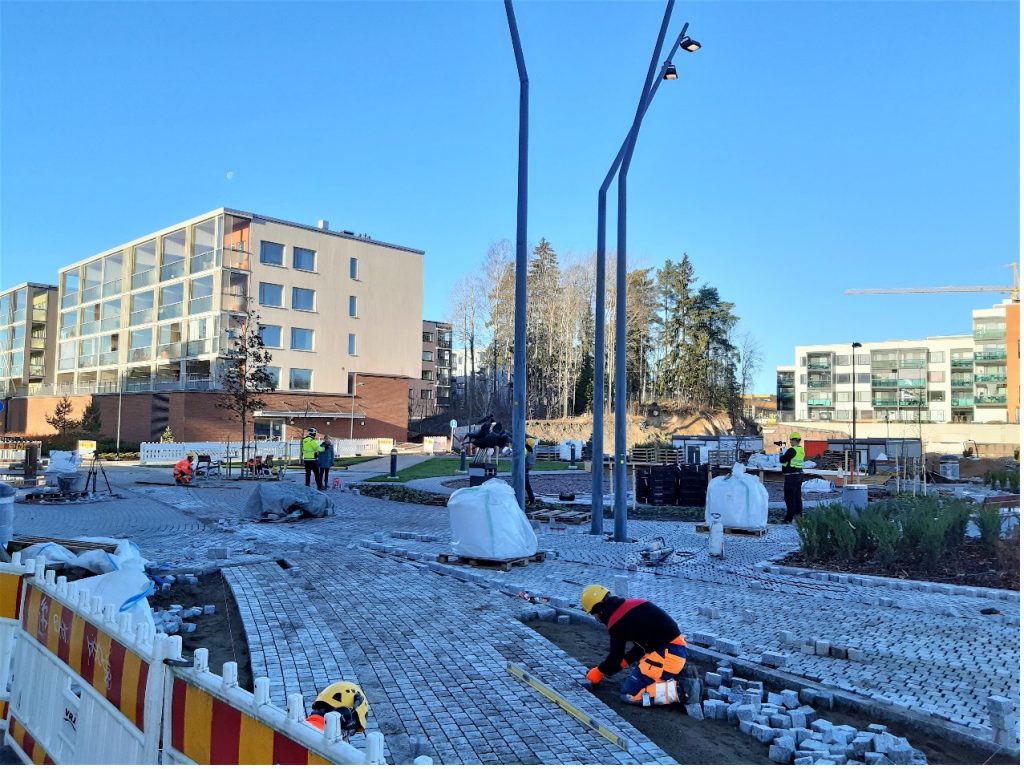
Principles of circular economy and resource wisdom put into practice on the Lukutori site thanks to EPD
To make sure the Lukutori site was resource-wise, the team used paving stones sourced from Finland instead of China, where the stones for infrastructure projects are usually imported from. This made it possible to reduce transportation emissions to the minimum. According to the Finnish public procurement act, requiring a product or material to be made in Finland is not allowed in the selection criteria, but the EPD value (Environmental Product Declaration) can now be used instead. Based on life cycle analysis, EPD is a voluntary and standardised declaration that reliably presents the essential and verified information about the environmental impact of a manufactured product or product range in a comparable manner. Using EPD as a selection criterion in public procurement is allowed.
The pilot site also applied principles of sustainable development laid down in the Espoo Story. VTT Technical Research Centre of Finland Ltd., an HNRY project partner, produced an emission assessment to determine how impactful the measures were.
Green Deal agreement for sustainable procurement and zero-emission construction sites in public procurement boosts development
The HNRY Project prepared the Green Deal agreement for sustainable procurement and zero-emission construction sites together with the Ministry of the Environment and the cities of Espoo, Helsinki, Vantaa and Turku. The Lukutori project team applied the criteria of the first target phase of the agreement where possible. The procurement criteria laid down in the Green Deal agreement takes into account aspects such as fossil-free motive power sources of heavy machinery and equipment, heavy goods vehicles and on-site electricity and heating as well as the development of lower-emission practices to be adopted on the site. Procurement practices in the public sector have the potential to have a huge impact on the amount of these emissions. At the same time, the public sector can pioneer the use of alternative motive power sources, boost demand and create the conditions for developing the market for low-emission solutions.
TAKE-HOME MESSAGES
- The importance of market dialogue: engage contractors and other stakeholders as early as when planning the contracting tender. Each site has its own clear / most significant possibilities for emission reduction, and these should be examined together with the stakeholders to find the most cost-effective and practical solutions.
- With the help of information and genuine dialogue, prevailing attitudes in the construction industry can be influenced to increase awareness of climate matters quickly enough.
- Carbon-neutral construction techniques and strategies are not more expensive when the costs are analysed over a longer period of time and when the goal is to apply the principles of sustainable construction in other areas as well.
- Contractors and other stakeholders are well-informed and ready to take action; those in charge of public procurement must not hesitate to develop the procurement process and to demand more in terms of taking the environment into account and applying the principles of circular economy.
“Thank you for supporting Finnish workmanship and the Finnish stone industry. As a geologist living in Espoo, I enjoy reading these articles.”
– A reader’s comment on a blog post about the pilot project.
Download
Links
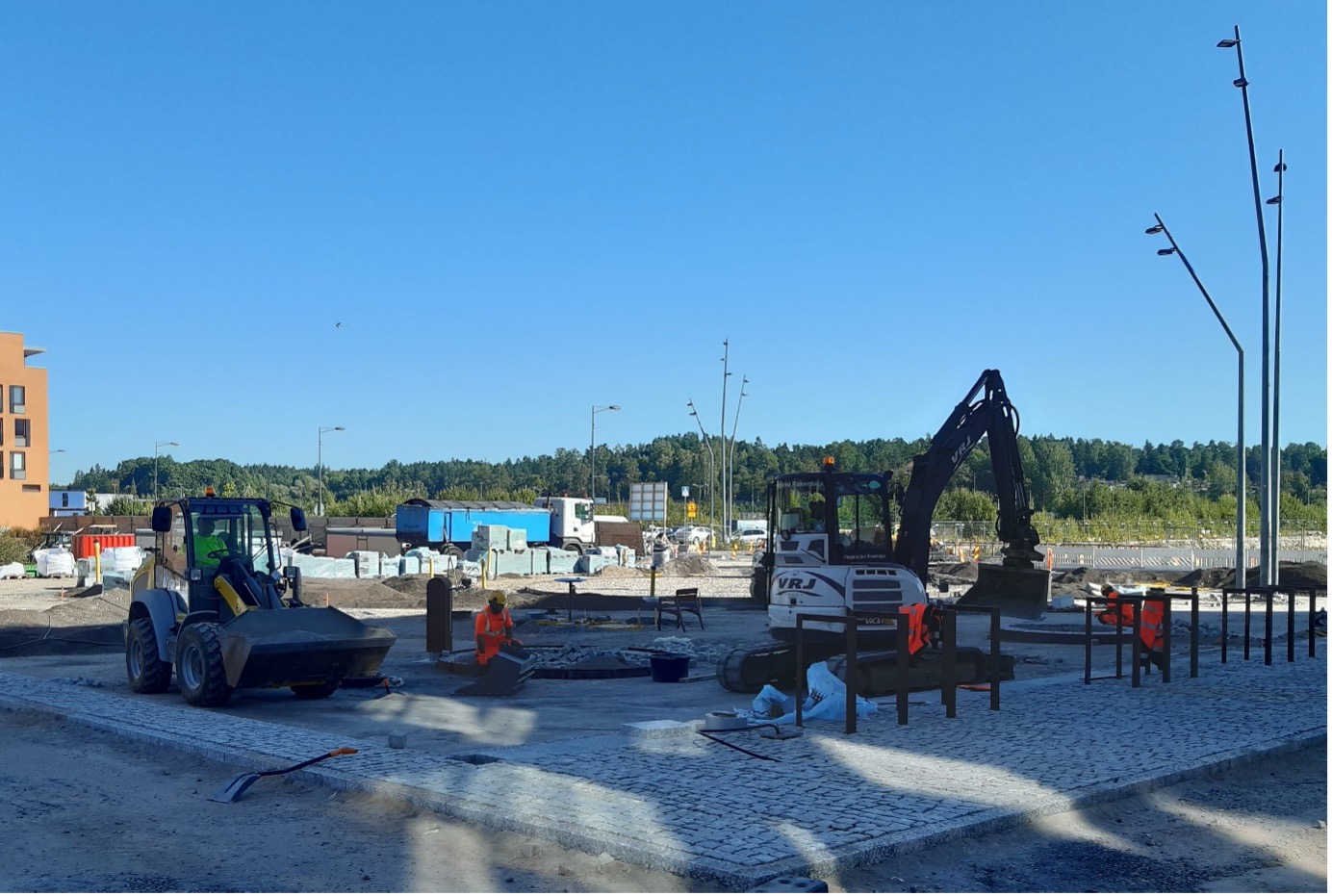
How can we calculate the carbon footprint of a construction site?

Construction site carbon footprint calculations
construction site, carbon footprint, greenhouse gas emissions, climate change mitigation, sustainability, building and construction, life cycle assessment
The success of the efforts to reduce emissions from the construction site of the Lukutori square in Espoo was evaluated through a carbon footprint assessment. Measures taken on the site were found to have had a significant impact on emission reduction: emissions from the construction of the Lukutori square were 25% of the emissions from a traditional construction site. The assessment can be used to set targets for the effective reduction of carbon footprint on construction sites and to define the measures that must be taken. It also makes it possible to examine emissions in a comprehensive manner and helps identify the most critical processes in terms of emission reduction goals.
- A comprehensive examination: the majority of emissions were caused by emissions other than direct emissions from the construction site, which is why the project also took into account emissions from materials and energy production;
- −75%: thanks to the measures to reduce emissions from the Lukutori construction site, its emissions were 25% of the emissions from a traditional construction site;
- savings: in the Lukutori project, the biggest savings were achieved through the use of Finnish rocks instead of rocks imported from China. Another significant factor was replacing fossil fuel-powered heavy machinery and equipment with electric machinery and equipment.
This solution is right for you if
- you work in the procurement or construction division of a local authority; or
- you manage or represent a construction company and you are looking for new low-emission solutions.
BASIC FACTS
Project party: VTT Technical Research Centre of Finland Ltd.
Contractor: VRJ Rakennus Oy
Pilot site: Lukutori square, Espoo
Time frame: 6/2020–11/2020
Emission calculations provide information about the area’s carbon footprint
The term carbon footprint is used to describe the total greenhouse gas emissions caused by a product, activity or service. It tells us how much greenhouse gas emissions are generated during the life cycle of a product or service. When net greenhouse gas emissions are reduced, the carbon footprint of the activity becomes smaller. In a carbon-neutral society, the amount of greenhouse gas emissions released into the atmosphere by the society is the same as the amount it can capture, meaning that its net carbon footprint is zero. To be able to determine if an activity is carbon neutral, we must assess its carbon footprint throughout its entire life cycle.
Emissions calculations can be based on production or consumption. Production-based emissions calculations examine the emissions generated in a certain area, and this method is typically used to calculate the amount of emissions caused by different countries. The consumption-based approach, on the other hand, examines emissions caused by the manufacture, transport and disposal of the products or services produced and consumed, for example, by a certain community or area over a specific period of time. In the calculation of emissions from an industrial area, the consumption-based method produces more meaningful results and it is also widely used. As such, the calculations for this project were also made using the consumption-based approach.
Towards emission-free construction sites with carbon footprint calculations
The concept of carbon-neutral construction sites is divided into five phases, which are: 1) setting targets; 2) calculating current emissions; 3) identifying possibilities for carbon reduction; 4) drawing up the carbon reduction plan; and 5) implementing and verifying measures to reduce emissions.
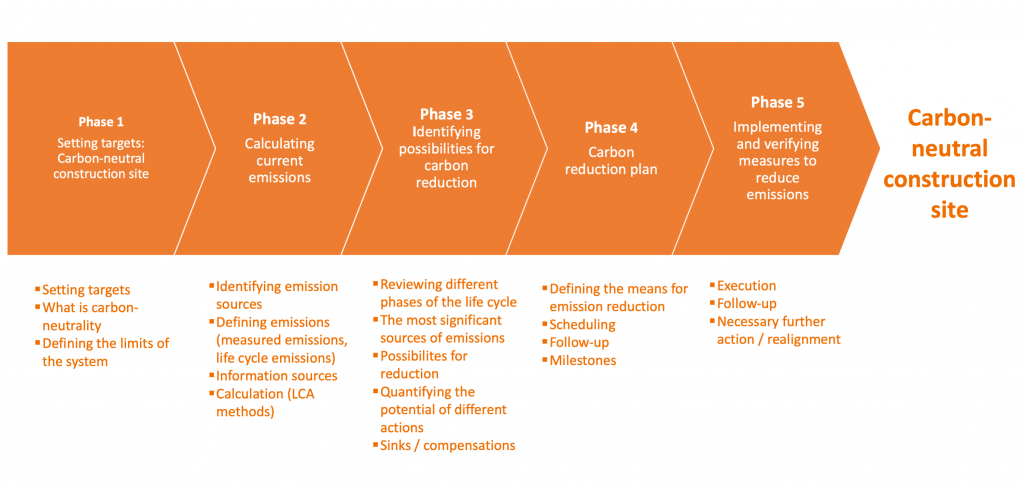
In phase 2, the project team used the Greenhouse Gas Protocol1, which is one of the world’s best-known and widely used calculation methods. In the calculation, emissions were divided into three scopes:
- Scope 1: direct greenhouse gas emissions, which are generated as a result of a company’s activities on site, or physically in its offices and production facilities.
- Scope 2: indirect emissions from the generation of purchased energy, or emissions caused by the production of electricity, heating and cooling used by the company (if electricity is produced off site and the company buys it).
- Scope 3: indirect greenhouse gas emissions that are caused by the company’s activities. Indirect emissions are known as “upstream emissions”, which are the emissions that are caused by the manufacture of the products the company uses in its production processes and/or the emissions caused by the use and disposal of these products.

Impact of the concept on carbon neutrality and resource wisdom in the industrial area
Emissions from the pilot site were calculated using the method described above. The calculations covered the following aspects:
- Fuel consumption of heavy machinery and equipment and fuel production
- Emissions from transport, including fuel production
- Electricity production and batteries for electric heavy machinery and equipment
- Production of electricity consumed elsewhere on the site
- Materials used on the site
- Dry concrete
- Growing medium
- Rocks
- Crushed stone
- Cube-shaped paving stones
To illustrate the relative significance of the emission reduction measures implemented on the Lukutori site, the project team compared two different scenarios in the calculation: the actual situation of Lukutori and a made-up comparison scenario, in which no solutions to reduce greenhouse gas emissions had been implemented. The comparison scenario was based on three assumptions: all heavy machinery was powered by fossil diesel fuel (the consumption of electric heavy machinery was calculated based on the horsepower and operating hours of equivalent machinery), the electricity used was the equivalent of an average Finnish electricity network, and the stone materials were imported from China.

The results showed that the greenhouse gas emissions caused by the Lukutori construction site were approximately 90 tonnes of CO2 equivalent, while emissions in the comparison scenario amounted to 360 tonnes. In other words, the emissions in the comparison scenario were about four times as high as the emissions from the Lukutori site. In the Lukutori project, the biggest savings were achieved through the use of Finnish rocks instead of rocks imported from China. Another significant factor was replacing fossil fuel-powered heavy machinery and equipment with electric machinery and equipment.
Since the Lukutori site was relatively small and the project duration short (approximately six months), concept phases 4 and 5 were not included in the pilot project. During these phases, the project team would have examined possibilities for emission reduction, drawn up a plan to implement and monitor these possibilities and prepared a closing report detailing how well the goals were achieved. Implementing the concept not only provides a set of tools to reduce emissions from an ongoing site, but also ideas and instructions for implementing low-emission alternatives on future construction sites.
TAKE-HOME MESSAGES
- It is important to assess emissions in a comprehensive manner.
- Attention should be paid to the ambitiousness of emission reduction targets and actions.
- Significant emission reductions can be achieved by also taking materials into account.
- In addition to purchased materials, switching to electric heavy machinery and equipment is also an essential strategy to reduce emissions.



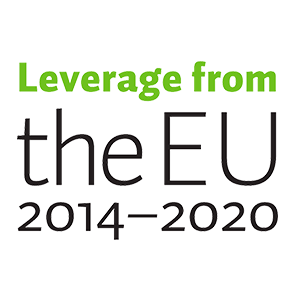
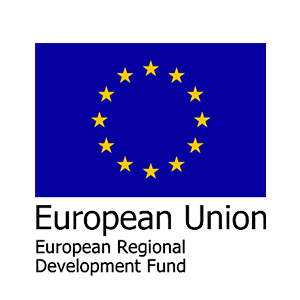
 VTT kehittää Helsingin, Espoon, Vantaan ja Turun yritysalueille vähähiilisiä toimintatapoja
VTT kehittää Helsingin, Espoon, Vantaan ja Turun yritysalueille vähähiilisiä toimintatapoja